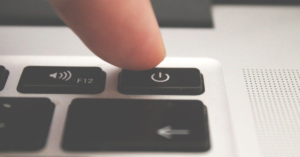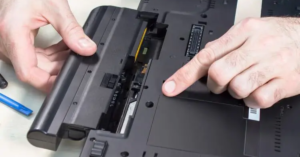A notebook is defined as a personal computer which is portable and smaller in size than a briefcase which can either be charged with a battery or plugged into an AC power source. Such computers are quite useful when used in temporary locations like during flights, at a library, in temporary offices, or during a meeting. A notebook computer is more often called a laptop and typically weighs less than five pounds and measures less than three inches in thickness.
Acer, Apple, Asus, Dell, Hewlett Packard, Lenovo, and Microsoft are the best-known companies that produce laptop or notebook computers. Some companies that were already at the top of the notebook market, such as IBM and Toshiba, have given it up while other companies like Compaq simply disappeared.
Characteristics of a Notebook Computer
Notebook computers are devices known as laptops, which are lightweight and easily portable. These are in fact portable computer systems that replicate a desktop computer in virtually all aspects except for mobility which comes in very handy for students, employees and even some casual users.
A notebook computer can be described by some of the most common features:

- Users seeking to carry their notebooks around where they don’t take much weight are likely to appreciate notebooks.
- In most cases, screen size for the notebook does not go below 10 inches or exceed 17 inches. In many cases though, the sizes for most notebooks tend to be around the 10- to 17-inch mark with significantly high definition options available such as Full HD and 4K resolutions.
- No user wants to clutter their desk with auxiliary devices, especially when notebooks come with both a touchpad and keyboard.
- Being completely wireless designs, it is easy to sweep around with laptops, making them appropriate on the move.
- Modern day notebooks incorporate strong processors, enough RAM and SSD storage to support such activities as fast booting, multitasking and operation of demanding applications.
- Thanks to Wi-Fi, Bluetooth, USB and HDMI ports, notebooks can be easily connected to the network, devices and external displays.
- Notebook computers have been designed with low power consumption in mind, therefore their batteries last more and energy expenses are lower than those of desktop computers.
- Some of the units are equipped with fingerprint and data encryption technology which guarantees the user’s privacy and protection of information.
Notebook computers have all the qualities of mobility, functionality and performance which makes them a fundamental device in today’s world.
Components of a Notebook Computer
- Display Screen: Built-in high-resolution screen for visual output.
- Keyboard: Integrated keyboard for typing and input.
- Touchpad: A built-in pointing device for navigation.
- Processor (CPU): The brain of the notebook that processes tasks.
- Memory (RAM): Temporary storage for running applications smoothly.
- Storage (HDD/SSD): Space to store files and system data.
- Battery: Rechargeable power source for portability.
- Motherboard: The main circuit board connecting all components.
- Graphics Card (GPU): Handles rendering of visuals and graphics.
- Speakers: Built-in audio output for sound and media.
- Webcam: Integrated camera for video calls and recordings.
- Ports and Slots: USB, HDMI, and other connectors for peripherals.
- Wi-Fi and Bluetooth Modules: Wireless connectivity features.
- Cooling System: Keeps the notebook from overheating.
- Power Adapter: External charger to recharge the battery.
- These components work together to deliver a seamless computing experience.
Benefits of Notebooks
A notebook computer comes with the following advantages:
Portability and convenience. With notebooks, an individual can perform most of the functions handled by a workstation. With the exception of the size and weight, notebooks are highly useful compared to the rigidness of a desktop workstation. Traveling employees can carry their notebooks and with them, access any application and any required data.
Workplace flexibility. Also, because of mobile computing devices, like notebooks, employees can work from where they are required. For example, during the COVID-19 pandemic, a lot of people used notebooks to work from external areas instead of going to the office if there was a need to take care of children at home.
Cost savings. With potential savings realized in organizations not having the need to purchase numerous computers for employees, although notebooks may be initially expensive.
Disadvantages of Notebooks
Limited advanced capabilities. A notebook’s processing power is often insufficient for use with applications that require intensive graphics or graphics design for finer work or with applications that require heavy duty data analysis.
Cost. Apart from specifications and design, the manufacturers for notebooks can be costlier that standard desktop.
Battery issues. In some uses a notebook’s function may be restricted due to battery energy.
Size. Notebooks are smaller than desktop computers but they are larger than netbooks which are more slender and a lot lighter in weight and smartphones including tablets. Their smaller screen size may also be a hindering factor for some applications.
Best Notebook Computer in 2025
Wondering which notebook computer to buy in 2025? Look no further here are our favorite recommendations for all types of users:

MacBook Pro M3X
The MacBook Pro M3X should be the first choice for any professional or power-user, as it features high-performance and admirable efficiency. This sophisticated model is made for getting the job done, with demanding tasks made effortless with its advanced design features and specifications.
Dell XPS 15
The Dell XPS 15 is more versatile than other notebook computers because it’s designed not only for superior performance but also for better looks. Since it has beautiful visuals integrated within its great essentials, this unit is ideal for creators and users who are seeking high-design systems.
HP Spectre x360
HP Spectre x360 on the other hand is both a convertible notebook and a 2-in-1 laptop; thus it brings out class and flexibility. However, this model is also made for easy use, as it comes with powerful technology and long lasting batteries, which make it perfect for all sorts of mobile users.
Acer Swift Edge 3
The Acer Swift Edge 3 is as affordable as they come and it is towards the budget range of notebook computers but this doesn’t mean that its performance is lacking. This model has proven to be an even better option because it provides good performance at an affordable price within the boundaries of most students and casual users.
These notebooks are just the tip of the iceberg of what’s on offer in the 2025 market. No matter if you are a professional, gamer, student, or just an average user, there is surely a notebook computer that would tarry your requirements and spirits alike.
Difference Between a Laptop and a Notebook
Although laptops and notebooks are typically considered the same, there are small distinctions. The two are both mobile portable computers or rather mobile computing devices, but their dimensions, features, and their primary target are different.
Size and Portability
The general rule states that notebooks are improved versions of the common laptops, as they are thinner and smaller. Portable Computers are less shipping devices since their primary focus is on portability, whereas Laptops are larger in profile due to their drug hard devices.
Performance
A basic laptop is superior and better as compared to a satisfactorily performing Android tablet. Because of having fans, batteries, and CPUs they provide better performance and possess a better signature, supporting abstract graphic users, and have larger storage units. Only performing primary henpower computer tasks including web browsing, and editing documents and files.
Power Time Management
As they are designed for lightweight purposes, Notebooks have longer battery times. Less demanding laptops have lesser battery life because they use more power.
Use Cases
With having a notebook, tasks like writing, streaming or browsing become very easy since the notebook’s size doesn’t bother much. In contrast to notebooks, laptops are devices meant to endure load tasks like video making, and gaming whereas software typing and development do require much load.
To gain further understanding of the overlap between the terms “laptop” and “notebook,” please refer to Why Laptops are Called Notebooks?.
What is a Composition Notebook?

A composition notebook is a type of paper notebook that is used to write, take notes, or journal. Famed for its cover which is strong with a black and white marble color, this notebook has pages designed to be strong enough to reduce or prevent tearing out of pages which are secure and quite hard to pull out as they are sewn together on a spine.
Due to their affordability, use and ease they are favored by a lot of students and even professionals during class or work periods. They have ruled pages which further facilitates the ideas of the writer into an organized way of writing. The pages of the composition notebook are less likely to be detached even during excessive usage owing to the sewn binding that is present which is in contrast to spiral notebooks.
PC or Notebook: What’s the Difference?
The terms ‘PC’ (Personal Computer) and ‘Notebook’ might be used interchangeably but still, they are different devices and used for different purposes.
Form Factor
PC: Also, termed as a ‘desktop computer’. It is designed to be stationary and typically consists of a separate monitor, CPU, keyboard and mouse.
Notebook: An all-in-one portable device which comes with a screen, keyboard, and a touchpad.
Portability
PC: Large and immobile. These are intended to be used in places like an office or a house.
Notebook: Small and light in weight. Easily usable and preferably portable.
Performance
PC: Have better performance parameters because it has a more powerful chipset, wonders as better cooling, and is upgradeable.
Notebook: Focused on energy and portability, is used for daily requirements but has minimal upgrade capabilities.
Usage
PC: Mostly used for heavy work which entails 3D gaming, 3D modeling and video editing.
Notebook: Best used for activities which involve browsing, writing and streaming.
In conclusion, whether a PC should be chosen over a notebook or vice versa depends on the usability. If performance and personalization is needed, then the PC is preferred while if convenience and mobility is the goal, then the notebook is ideal.
Notebook vs Desktop Computer
| Feature | Notebook | Desktop Computer |
| Portability | Easy to carry, lightweight, and perfect for working anywhere. | Stays in one place and isn’t built for moving around. |
| Performance | Great for everyday tasks like browsing and writing, but struggles with heavy work like gaming or video editing. | Handles demanding tasks with ease, like gaming or professional design work. |
| Customization | Limited options for upgrades; most parts are fixed. | Easy to upgrade and customize components like RAM, storage, and graphics cards. |
| Price | Costs more for similar performance due to its compact design. | Offers better performance for the price, giving you more bang for your buck. |
| Display Size | Comes with a smaller screen, usually between 10 and 17 inches. | Works with larger monitors, usually 20 inches or more, for a better viewing experience. |
| Power Supply | Runs on a rechargeable battery, so you can use it without being plugged in. | Needs to stay plugged in all the time—no battery option. |
| Space Requirement | Compact and fits on small desks or even in a bag. | Takes up more space with its monitor, CPU, and accessories. |
| Usage | Ideal for basic tasks and people who need to work on the go. | Perfect for power users who need high performance and long hours of use. |
| Durability | More likely to get damaged due to frequent movement. | Stays safe and durable as long as it’s kept in one place. |
| Connectivity | Has fewer ports but comes with built-in Wi-Fi and Bluetooth. | Offers more ports for connecting multiple devices like printers and monitors. |
Notebook Computer Accessories
Though notebook computers can be independent devices and don’t actively require any accessories to work with what they have, pairing them with the right accessories will increase not only one’s productivity, but also one’s comfort and the overall experience.
Some of the practical accessories for notebook computers include the following:
Laptop Bag or Sleeve
Keeps the notebook safe from scratches, bumps, and dust when traveling with the device, and ensures that the bag is light and portable.
External Mouse
With more accurate controls, it is ideal for activities such as games, designing, and engaging in extensive web browsing.
Cooling Pad
Aids in reducing the chances of overheating of a notebook that is used for a long time.
External Keyboard
This is beneficial when it comes to typing over a long period of time as well preventing the built-in keyboard from wearing out.
Laptop Stand
The strain on the neck and back is reduced as this prevents one from looking down at the notebook and instead, has it raised to eye level,
Portable Charger (Power Bank)
With this, notebooks are recharged while on the move so that there is no interference while one is working while traveling.
USB Hub
With this, one is able to purchase flash drives, printers, or external storage, and connect them to the computer through the USB ports.
External Monitor
This adds another work area which is useful when you are working on several tasks that require focus, attention to detail and creativity or when you are watching a movie or a series.
Headphones or Earbuds
These are of great help as the quality of the audio calls, music and video streaming can be enhanced while maintaining sound privacy.
External Storage (HDD/SSD)
This is useful for keeping backups, large files and projects without clogging up the internal space of the notebook.
These add-on devices, in addition to enhancing the functions of your notebook, will also make you more comfortable and helpful in different activities such as work and studies or when watching movies and the likes.
Best Small Notebook PC
In today’s world, smaller and more effective computers are used on the go to carry out work efficiently or complete tasks which would ideally take a more powerful and efficient machine. These small and compact devices are usually called Small Note Pcs.
Best Recommended Picks for Small Note Pcs
- Microsoft Surface Laptop Go 3: Surface Laptop Go 3 gives a light, portable Surface touchscreen laptop with a 12.4” PixelSense™ display. At 2.49 pounds, it’s small and light enough to take it the whole day to get more done—whether it’s for work, school, or yourself.
- Asus E210 Mini: Lightweight and compact, it sports a stylish new look that fits right in with your dynamic lifestyle.
- Lenovo ThinkPad X1 Nano:The Lenovo X1 Nano’s name implies it’s small—and that’s correct. It measures less than a foot across and less than .58 inches thick. It’s also light, weighing a mere 2.18 pounds.
- Asus Vivobook 13 Slate: It is a convertible tablet with full support for Windows 11 and mainstream PC apps
Factors to consider while purchasing a Mini Notebook PC

Screen Size: From 10 inch to 13 inch on average this makes it ideal for carrying in bags and is very light weight.
Weight: Typically weighs around 3 pounds approximately, this makes it so easy to use on a daily basis.
Self-Contained Battery: With a built in capability of around 10-15 hours of use, makes this ideal for business or laptop users.
Performance: Small and note pcs can easily boot applications or programs quickly due to SSD storage.
Build Quality: Due to frequent traveling, most of such devices are made from either magnesium or aluminum.
USB-C, HDMI, Wi-Fi, Bluetooth: These are some standard connectors that make connecting with peripherals very easy.
Another Name for a Laptop
A laptop is usually referred to as a notebook, portable computer, or only as a notebook. In the 1980s and 1990s, the term “notebook” became popular because the designs of the laptops were in the form of a notebook or binder in terms of size and portability. These names focus on the small and lightweight characteristics of laptops which make it easy for the users to move around and use it in various places.
The other terms being used in the interchange also give meaning to the primary objective of the device that is enabling desktop computer functions in the portable devices. However, from latest usage, presently “laptop” seems more widely used whereas “notebook” which at one time was popular is used more often in marketing for advertisements, to describe the thinner models which are more convenient during traveling.
Conclusion
Notebook computers or laptops have been accepted as important tools in the modern world today owing to their portability, versatility and performance. Their structure, light-weight, advanced features, and energy consumption make them suitable for casual, students, and professional users.
Notebook computers may be smaller than the desktops, however they are still able to perform most of the basic functions, as well as run some of the more resource-intensive tasks, providing the convenience of a portable device without losing out on functionality. Thanks to progress in technology, modern notebooks now feature powerful hardware, high-resolution displays and even better hardware security that makes them useful in different spheres.
Get further understanding of the types of laptops.
FAQ’S
What is a notebook computer used for?
A notebook computer is used for portable computing tasks like browsing, document editing, streaming, and light productivity work, making it ideal for students and professionals needing a lightweight personal computer.
What is the difference between a laptop and a notebook?
The main difference between a laptop and a notebook is size and portability; Notebooks are slimmer and lighter, designed for basic tasks, while Laptops are larger and more powerful for demanding applications.
Is a notebook better than a PC?
A notebook is better than a PC for mobility and convenience, while PCs excel in performance and customization, making the choice dependent on whether you need portability or processing power.
Why are laptops now called notebooks?
Laptops are called notebooks due to their compact, lightweight design resembling a traditional notebook, emphasizing portability and ease of use for mobile computing tasks.
What is a notebook on my computer?
A notebook on your computer refers to a lightweight laptop designed for on-the-go use, offering essential features for everyday computing in a portable format.
Is a notebook the same as a laptop?
A notebook is a type of laptop, typically lighter and slimmer, designed for basic computing tasks and portability.
What is the Smallest Notebook Computer?
The smallest notebook computers, like the Microsoft Surface Go, have 10-inch screens and are ultra-lightweight for maximum portability.










